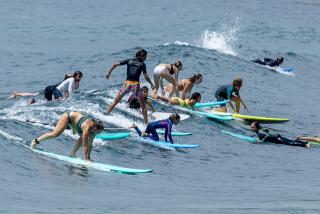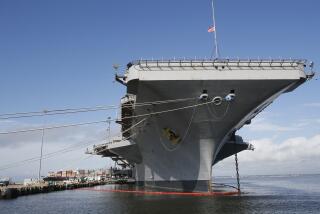Lack of Courtesy at Sea and at Anchorage a Problem
- Share via
Many experienced sailors have expressed dismay that there is a lack of courtesy afloat these days.
They are concerned, among other things, about close calls between powerboats and sailboats, drunkenness at the helm, early morning running of generators, loud radio music and abuse of VHF radio channels.
I feel that one of the most telling complaints centers around a growing number of sailors who display a shocking ignorance of how to enter an anchorage, select a spot and anchor correctly.
My wife and I have suffered skinned knees from crawling around on our foredeck while hauling anchor or shortening scope to avoid a poorly anchored yacht threatening us. We’ve also had to reset our anchor because some knucklehead came in at night and dropped his anchor over ours and it began to drag and upset ours.
Some boaters seem unable to judge the arc of their vessel’s swing when the wind changes direction, with the result of bumping a neighbor. Others seem to have such great faith in the weight of their anchor, usually a 16-pound Danforth, that they simply drop it overboard and when it hits bottom they pay out a few feet of rope and promptly vanish below deck.
Somehow, the simple rule that at least three feet of anchor rope must be paid out to every foot of water depth and that the anchor must be dug in by straining upon the rope, never occurs to them.
Sailing Notes
With the gray whale migration south to the calving grounds of Baja California at its peak, a relatively recent threat to these travelers has been taking its toll of lives. Confirmed entanglements of whales in drift gill nets stands at 13 in 1985, according to Carl Nettleton, executive director of the National Coalition for Marine Conservation, Pacific Region.
“Government marine biologists have consistently stated that the number of gray whales killed is not harmful to their total population, but how many whale deaths are allowable? Maybe 50? 100? The truth is the agencies don’t know how many whales are being killed and are unable to find out,” Nettleton said.
Calling this an intolerable situation, he said that good estimates are urgently needed to make management decisions. Adequate funding and on-the-spot observations of the gill net fishing industry are a necessity, he said.
If you use radionavigation aids, then two Jan. 22 meetings in the Long Beach Harbor Dept. building may require your input. The public meetings are to review national plans governing the mix of federally funded and operated radionavigational aids. The plan is called the Federal Radionavigational Plan (FRP) and is co-sponsored by the Departments of Defense and Transportation.
The users of the following devices will be given an opportunity to comment on their requirements to this plan:--Loran-C, Omega, VOR, VOR/DME, VOTAC, TANCAN E. ILS, Transit, Radiobeacons, MLS and GPS. These meetings, scheduled for 2 p.m. and 7:30 p.m., will help form recommendations that will result in a national decision to determine which civil or government-provided radionavigation service can be terminated. Information about the meetings may be obtained locally from Jim Alexander at (213) 594-6058.
The Eagle Syndicate out of the Newport Harbor Yacht Club, an America’s Cup challenger, expects its 12-Meter Eagle to be launched this March. Eagle, designed by Johan Valentijn, is being built at the Williams and Manchester yard of Newport, R.I. The vessel is reported to have a “radical keel breakthrough.”
More to Read
Sign up for Essential California
The most important California stories and recommendations in your inbox every morning.
You may occasionally receive promotional content from the Los Angeles Times.













